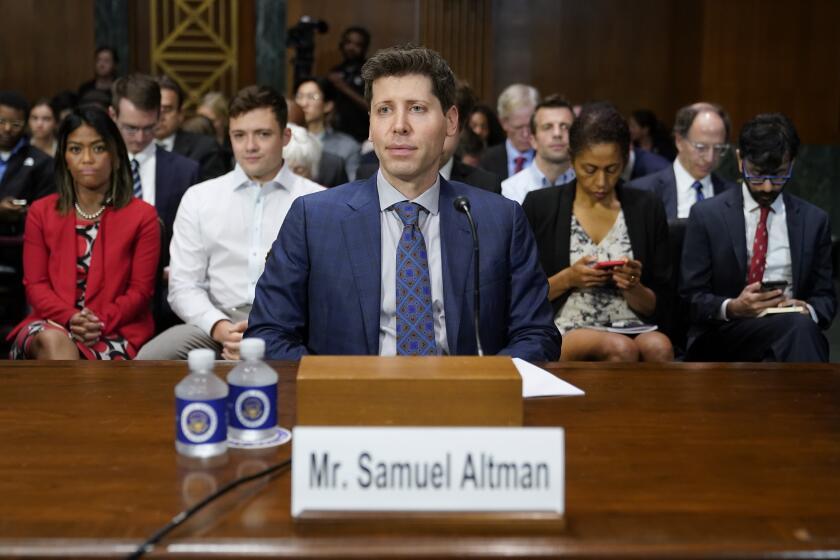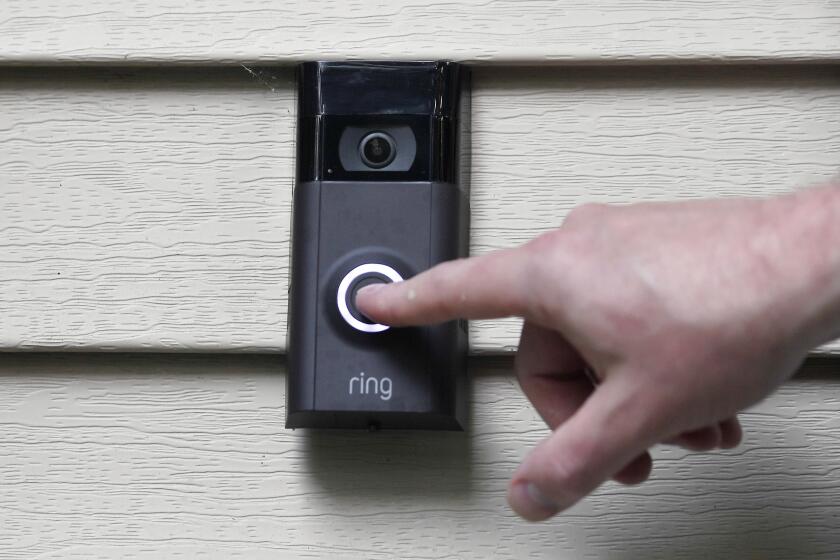This was the year of AI. Next year is when you should worry about your job

- Share via
The biggest story in tech this year was, without a doubt, the explosive ascent of AI. The biggest story in tech next year will be whether it can turn a profit. Because so far, it can’t.
A quick recap: OpenAI and ChatGPT burst onto the scene, dominated headlines, attracted millions of users and tens of billions in investment, and gave us 2023’s juiciest boardroom drama. Months of hand-wringing over whether AI is a grave danger or a major boon to society — apocalyptic talk that made for great product marketing — ensued from the world’s richest people. But the time for philosophizing is clearly over.
After the OpenAI board fired Chief Executive Sam Altman over concerns that “he was not consistently candid” last month, Microsoft, investors and employees on the verge of a stock option payout came roaring to his defense. Altman was reinstated, and the board purged those concerned with highfalutin things like “AI safety.” In their place now sits Larry Summers, the former Treasury secretary who thinks millions of people need to lose their jobs in order to cool the economy.
The message was clear: It’s time the world’s best-known AI startup cast aside the pretenses and prioritize profit over principles. And how will it do that? How will Big Tech sell AI? There are a few plausible ways, but one looms high above the others: Use it to help make Summers’ dreams come true — to automate work and cut labor costs.
This means that questions that have swirled this year — Will my boss try to replace my job with AI? Can my work really be automated away? — are about to become a whole lot more urgent and existential.
Questions like the above colored the major strikes in Hollywood, in which writers and actors in the WGA and SAG-AFTRA fought to keep studios from writing scripts or encoding actors with AI. Similar concerns led illustrators, artists and authors to file lawsuits against the AI companies for ingesting and repurposing their work without permission, and they’ve led to a fresh new wave of hardship for freelancers, who’ve already seen copywriting and graphic design gigs dry up in the shadow of generative AI.
But we haven’t seen anything yet.
See, we’re nearing the end of the Year of Generative AI, and few of the companies working in the space have pieced together a promising way to turn the hype into profits. The large language models are there — but the business models aren’t.
The hottest startup in Silicon Valley is in flames. So is the fiction that anything other than the profit motive is going to govern how AI gets developed and deployed.
In October, the Wall Street Journal ran a report headlined “Big Tech Struggles to Turn AI Hype Into Profits.” Before that, it warned that “AI Startup Buzz Is Facing a Reality Check.” Meanwhile, Gizmodo declared that “So Far, AI Is a Money Pit That Isn’t Paying Off.” The crux of the matter is the fact that these models are incredibly resource-intensive to run — asking ChatGPT to recommend a movie in its chatty, human-emulating style sucks down a lot more compute power, energy and, therefore, money than, say, a Google search. As the Journal memorably put it, using ChatGPT “to summarize an email is like getting a Lamborghini to deliver a pizza.”
Earlier this year, the Information reported that OpenAI’s server costs were estimated to be up to $1 million per day. And that’s on top of the company’s other overhead, of course, including labor and research and development costs. So generative AI companies are hemorrhaging money — not just OpenAI but Anthropic, Midjourney and tech giants like Google and Microsoft, too.
And now, the hype is cooling. In 2024, analysts, investors and business reporters will be wondering where the business is. It’s already not uncommon to hear observers remark that AI is a solution in search of a problem. In other words, there’s a real itchiness among backers and partners — who are reading headlines like the Journal’s and are beginning to wonder whether generative AI risks becoming another cash sink like the metaverse, NFTs or crypto before it — and among the companies desperate both to prove it isn’t and to strike before the hype iron goes cold altogether.
So, it’s time for Phase Two: to sell generative AI products to businesses with far deeper pockets than the average lay user, who is by now accustomed to using services such as Google search for free, and will be uninterested in paying a monthly fee to have ChatGPT tell them recipes. Besides, those sky-high user rates are already declining, suggesting that there is a ceiling on who might be willing to pay for a premium model to get faster and slightly improved results.
No, the generative AI companies will have to set their sights on enterprise customers, by making the pitch that AI is good for business. And how might AI be good for business? Well, it can automate tasks, it can cut labor costs, and it can generate efficiencies.
It can do people’s jobs.
Selling this idea has long been part of the plan. Back in March, OpenAI published a paper with University of Pennsylvania researchers that claimed that 80% of all American jobs were susceptible at least in part to being done by AI, a “finding” — not, the researchers hastily noted, a prediction — that doubled as a sales pitch for executives and middle managers interested in replacing some of their workforce with automated systems.
The holiday season is here, and with it ubiquitous guides to smart gadgets and tech toys. But what about the products we’re better off without? Our experts weigh in.
Months later, OpenAI rolled out its Enterprise service, touting another 80% stat — that 80% of Fortune 500 companies were already using ChatGPT in some form. It promises a service that works twice as fast as the product free to the public, with no usage caps, and full privacy. Businesses that opt for Enterprise tier GPT use will not have their data recorded or used in future models, a luxury not afforded to the public.
And Altman has leaned into promoting, essentially, the idea that his service will displace millions of workers. He’s been spending less time talking about how worried he is that AI will become so powerful that it will destroy humanity, and more time talking about how his products stand to eliminate jobs.
“I’m not afraid of [AI taking jobs] at all,” Altman said at a recent tech conference. “In fact, I think that’s good. I think that’s the way of progress, and we’ll find new and better jobs.” How reassuring for all those who like or depend on the job they have now! (Altman did also mention this will be a tough pill to swallow for many.) But it can all be seen as neatly fitting into the project of signing up more Enterprise tier ChatGPT customers.
More insidious to me than the pitch that businesses should start using generative AI to automate their workforces is the way Altman is aiming to push independent developers to do the same. When OpenAI held its first developer conference, just a week before the boardroom coup, the marquee announcement was that the company was going to launch its version of an app store and enable customers to make their own GPTs (it stands for generative pre-trained transformer) using OpenAI’s technology.
In return, OpenAI would take a cut of each custom GPT’s revenue. Furthermore, Altman announced that the company would provide a “legal shield” for anyone using its products. Remember those lawsuits from artists and authors I mentioned? OpenAI doesn’t want any developers to worry about little things like copyright when they’re building their AI products and tools — even if they’re ripping off the work of a working artist or two. (This is another arena in which generative AI companies are going to be aggressive in 2024. Venture capital titan Marc Andreesen recently claimed that if AI companies have to pay for the work they’re using to train their products, it would kill them — a dubious claim to be sure, but one that reflects how the industry plans on addressing issues regarding intellectual property and consent.)
All taken together, OpenAI has made it very clear that the time has come — it’s ready to hit the gas on mass automation in an effort to become profitable.
The tragedy of AI is not that it stands to replace good journalists, but that it takes every gross, callous move made by management to degrade the production of content — and promises to accelerate it.
Now, it needs to be noted that AI absolutely cannot replace most of the jobs that the AI companies are pitching businesses it can. But that doesn’t mean they’re not going to try — just ask the staff of Sports Illustrated. Over the summer, the CEO of an e-commerce company caught flak for announcing that he had replaced 90% of his support staff with ChatGPT. Digital media companies have announced investment in AI just after laying off staff.
The fear is that, caught up in the mania of AI, companies embed the tech in their systems, make premature layoffs, or cut freelancers or precarious workers — more and more modern workers are independent contractors, or gig workers, after all — and we see not an AI apocalypse but an awkward and painful corrosion of work across the board.
If 2023 was the year of AI hype, the fear is that 2024 is the year the hype train risks becoming a train wreck.
I do worry that if OpenAI tries to help Larry Summers get his way, things are going to get messy, fast. That working conditions will be degraded, and yes, that lots of people are going to lose their jobs or responsibilities before we realize that no, generative AI can’t do a lot of what’s promised, and industries either rush to course correct, hire part-time or less experienced workers to replace them, or offload more work onto the remaining workforce. I worry that the mere threat of generative AI being used to replace labor will be used to depress wages or as leverage against workers.
AI isn’t going to start doing your job next year. But in 2024, do expect OpenAI and the other AI companies to double down on their promises to change the world, to become more powerful than humans and start doing their work. Expect a lot of people to lap it up — Silicon Valley is counting on it.










